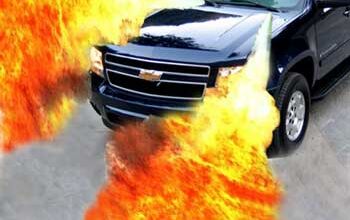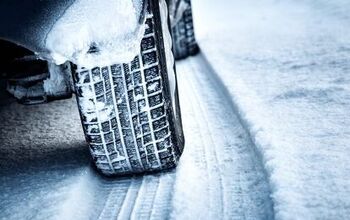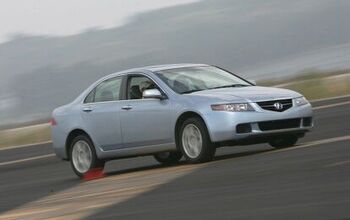Piston Slap: The Snow, The Lease And The Tranny

TTAC Commentator Jenneil624 writes:
I lease a 2008 Mazda3 2.3L with an automatic transmission and 30K miles. I have had the car for two years and have been very satisfied. I am strongly considering buying the car at lease end. Here is the problem. After one year of ownership, I got stuck in some snow and needed to aggressively rock the car free. It took so long to free the car that the transmission temporarily failed.
I put it in reverse and just revs – no power to the wheels. Then I put it in drive – same result. I assumed that I overheated the transmission fluid and let it rest for two hours. I went back to the vehicle after it cooled down and it worked perfectly. It has worked perfectly since, with no noticeable damage. I recently brought the car to the dealer for an unrelated warranty repair and the service advisor recommended a transmission fluid change. He said the fluid looked dark and needed to be changed. He knew nothing of my snow escapade. My question is – Has the transmission been damaged badly enough that purchasing this car would be a mistake? Would a transmission fluid change be enough to mitigate the damage I caused? Do I buy the car at lease end or turn it in and run away?
Sajeev Answers:
I’m with you. Because a transmission’s line (fluid) pressure greatly impacts operation, they tend to act funny when the fluid gets stupid hot. And I suspect that’s happened here. Whether or not your romp in the snow actually damaged the soft/hard parts inside the Mazda’s transaxle is truly anybody’s guess.
But I’ll play devil’s advocate, saying the transaxle was driven a long time on toasted fluid. Assuming this is a three year lease (please tell me you didn’t lease a car for longer), my rough timeline says you’ve driven on burned fluid for well over a year. If so, there could be permanent damage to items inside the unit. Maybe.
And, as discussed ad nauseam both here and any car forum, flushing old fluid can do more damage to a transmission’s soft parts (clutches, etc) than keeping the junky fluid around till death do us part. While this isn’t terribly likely in your situation, it’s possible.
And now, the advice you won’t normally see on a car message board: If you’d like to keep this car for 10+ years, I’d let the lease expire. FWIW, there’s a good chance you can buy the same or better Mazda3 on the retail used car market for less money. That’s the beauty of pre-recession leasing: residual values were so inflated that a car’s term value was far more than it’s actual market value. And you don’t wanna play that game anyway.
Send your queries to mehta@ttac.com
Piston Slap: The Snow, the Lease and the Line Pressure
TTAC Commentator Jenneil624 writes:
I lease a 2008 Mazda3 2.3L with an automatic transmission and 30K miles. I have had the car for two years and have been very satisfied. I am strongly considering buying the car at lease end. Here is the problem. After one year of ownership, I got stuck in some snow and needed to aggressively rock the car free. It took so long to free the car that the transmission temporarily failed.
I put it in reverse and just revs – no power to the wheels. Then I put it in drive – same result. I assumed that I overheated the transmission fluid and let it rest for two hours. I went back to the vehicle after it cooled down and it worked perfectly. It has worked perfectly since, with no noticeable damage. I recently brought the car to the dealer for an unrelated warranty repair and the service advisor recommended a transmission fluid change. He said the fluid looked dark and needed to be changed. He knew nothing of my snow escapade. My question is – Has the transmission been damaged badly enough that purchasing this car would be a mistake? Would a transmission fluid change be enough to mitigate the damage I caused? Do I buy the car at lease end or turn it in and run away?
Sajeev Answers:
I’m with you. Because a transmission’s line (fluid) pressure greatly impacts operation, they tend to act funny when the fluid gets stupid hot. And I suspect that’s happened here. Whether or not your romp in the snow actually damaged the soft/hard parts inside the Mazda’s transaxle is truly anybody’s guess.
But I’ll play devil’s advocate, saying the transaxle was driven a long time on toasted fluid. Assuming this is a three year lease (please tell me you didn’t lease a car for longer), my rough timeline says you’ve driven on burned fluid for well over a year. If so, there could be permanent damage to items inside the unit. Maybe.
And, as discussed ad nauseam both here and any car forum, flushing old fluid can do more damage to a transmission’s soft parts (clutches, etc) than keeping the junky fluid around till death do us part. While this isn’t terribly likely in your situation, it’s possible.
And now, the advice you won’t normally see on a car message board: If you’d like to keep this car for 10+ years, I’d let the lease expire. FWIW, there’s a good chance you can buy the same or better Mazda3 on the retail used car market for less money. That’s the beauty of pre-recession leasing: residual values were so inflated that a car’s term value was far more than it’s actual market value. And you don’t wanna play that game anyway.
Send your queries to mehta@ttac.com
Snowjob. Picture courtesy automobilemag.com

More by Sajeev Mehta
Latest Car Reviews
Read moreLatest Product Reviews
Read moreRecent Comments
- Kwik_Shift_Pro4X I wonder if Fiat would pull off old world Italian charm full of well intentioned stereotypes.
- Chelsea I actually used to work for this guy
- SaulTigh Saw my first Cybertruck last weekend. Looked like a kit car...not an even panel to be seen.
- GregLocock Bear in mind this is purely a branding exercise and has no significant input from AM. Buying one of these is like buying a Pink Floyd T shirt, no Dave and Nick didn't personally sew it up for you.
- Lou_BC This is the sort of thing that lands 15 billion dollar Honda investments in Canada. One political party tries to undo everything the other one has done.


































Comments
Join the conversation
In very few instances does your buy out price in leases actually provide a good deal. Unfortunately - and especially with the free fall in BOF SUVs and pickups due to gas prices and other factors - most buy out prices are much higher than FMV. To even further make it hard for lessees to buy their car out...the lessor is likely unwilling to negotiate the buy-out price even knowing that if they don't sell it to the lessee it will sell at auction for substantially less. I never understood the lessors unwillingness to treat a buy out instead as a simple used car purchase at lease end.
Disclaimer: I took Driver Ed in 1975. If the wheels are spinning you're doing it wrong. Yes, shift from drive to reverse to get momentum as you rock the car; eventually you will (hopefully) get up enough motion to get the car moving to the point where your tires can gain traction and you can get on your way. At no point in this process will your engine likely turn at over 1200-1500 RPM. With a lot of automatic transmissions, you may not even need to hit the gas pedal--the amount of power that lets your car creep when you take your foot off the brake may be enough. Seriously, for those of you who don't know how to drive in snow: If the wheels are spinning, you're doing it wrong. If you have traction control it might bail you out if you're not stuck too badly, but the modern corollary holds: if the traction control kicks in, you're doing it wrong.